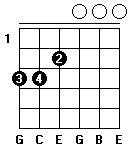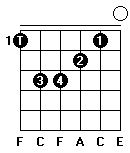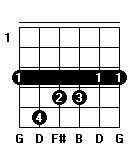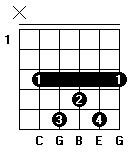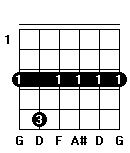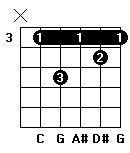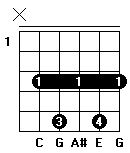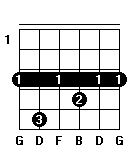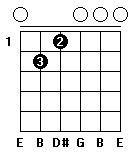Seventh Chords (lesson)
Contents |
Introduction
In our journey towards understanding chords, we have looked at Power Chords which are combinations of 2 notes, and triads which are combinations of 3 notes. Power chords and triads are both relatively simple types of chords, yet they account for the majority of chords in use in popular music with one exception; that of the 7th chord. In this lesson we are going to look into the various types of 7th chord, and then in the next lesson move on a step to look at extended chords which are used a lot in Jazz.
Triads and Relative Intervals
So far, we have seen chord construction that consists of stacking notes separated by one tone on top of each other. For instance a major triad is a Root, 3rd and 5th interval. But we can also look at this in a slightly different way and figure out the relationship between the notes by looking at the interval between succesive notes, rather than the interval from the root as we have been doing until now. So for our major triad we can describe it as a major 3rd between the first 2 notes, followed by a minor 3rd between the second 2 notes. Lets look at an example, the chord of C Major.
The notes are C, E and G. If C is the root, E is a Major 3rd and G is a perfect 5th, no surprises there. If we look at it in relative terms, the interval between the C and the E is still a Major 3rd of course, but we can now get to the next note (the G) by describing the interval between the E and the G rather than the C and the G - that gives us a Minor 3rd. So, we can describe a Major triad as a Major 3rd followed by a Minor 3rd. When we do this, we are constructing what are called "tertian chords", by starting on a root note and stacking two 3rds on top of each other. To get the different flavours of triad (major, minor, augmented, diminished) we just need to vary the type of 3rd interval we are using, like this:
So we can build any triad type out of two 3rd intervals. One way of building more complex chords is to extend this principle and add another 3rd on top of the triad, which will end up giving us some flavour of 7th chord.
Sevenths - What are they?
We know from our study of intervals that there are 2 types of 7th interval - a Major 7th and a Minor 7th. There is no augmented 7th because that would be the same as an octave (because in the major scale ther is only a semitone betwen the 7th and octave, meaning that if we augment the 7th we end up with an 8th. The same is true of a 3rd, an augmented 3rd is the same as a perfect 4th). A 7th is also a 3rd up from a 5th, meaning that if we take a triad and stack another 3rd on top of it we will end up with some sort of 7th chord. As you might expect, the type of 3rd we use determines the type of 7th chord we get. In addition, varying the absolute 3rd interval between major and minor allows us to create 4 main variations of a 7th chord.
Although the most important interval in a chord is generally speaking the 3rd - it governs whether the overall chord is major or minor - the 7th is also pretty important when it is represented. By varying these two notes of a chord you can create a huge range of tonal colorings.
Lets take a look at all the common combinations of chords with a 7th and see what they are called.
These are an interesting bunch of chords. The Major 7th is a rich but sad sounding chord, it works really well on an acoustic guitar. The minor 7th makes a good and very subtle replacement for a regular minor chord. The 7th or Dominant has a triumphant kind of feel to it. Of all of them, the only one not in common usage is the minor major 7th.
The minor major 7th although not common deserves some discussion, not least because of its confusing name. The key to understanding this chord is to realize that the "minor" refers to the 3rd interval (a minor 3rd, making the chord minor overall) and the "major" refers to the 7th interval - a major 7th. Think of it as "C minor ... with a major 7th", then remove the "... with a" and it should make sense! The Minor Major 7th is a fairly unusual chord and not particularly musical, but it is dramatic, a feature that qualifies it to be the chord that the James Bond theme fades out to!
Major 7ths
Ok, lets see some examples of how we would play these chords. A couple of really good open string variants are Cmaj7 and Fmaj7 - together they make a great progression, and are played like this:
The thumb placement here is optional, you could remove the thumb and just not play the 6th string, however, played as shown above it is a beautifully full and resonant chord.
As bar chords, there are two main major 7th shapes (although there are others), based on an open A major 7 and an open E major 7.
Minor 7ths
Minor 7ths work well as bar chords, based on the Em7 and Am7 shapes respectively, for instance:
Dominant 7ths
Dominant 7ths also work well as bar chords, based again on the E7 and A7 shapes:
As usual, once you have the hang of a particular bar chord you can move it up and down the fretboard to abtain any chord of that type that your heart desires.
Finally, an example of a minor major chord, E minor major 7 - an open chord that is realtively easy to play:
Note on chord symbols : Triads are nice and simple, and everyone agrees on the symbols to use for them. For 7ths and more complex chords, there are a number of different naming schemes. In a perfect world we would all use the same one, but everyone will tend to use the one they are taught. For that reason, we need to learn various variants for chord naming. I have listed the most common ones, but there are others.
Seventh Progressions
The various flavours of 7th chords are very important when constructing progressions around the major modes. Several of the modes have variations of seventh chords as their charcteristic root chord, and understanding of the tonalities of these chords can help a lot when you are improvising in different modes. For example, Dorian and Phrygian both have a Minor 7th root chord. Lydian has a Major 7th root chord, and Mixolydian has a Dominant 7th root chord. Knowledge of these different chords and how they sound can give you a lot of insight into the flavour of the different modes.
Another fun thing to do is to make up a chord progression based on a constant root chord with a varying 7th flavour. One of my favourites :
C, Cmaj7, C7, F (used to great effect in "Something" by the Beatles)
Looking at the notes in those chords:
C - C E G C Cmaj7 - C E G B C7 - C E G Bb F - F A C
You can see there is a progression through the chords in which one note changes step by step. Starting with the top C in the C major chord, we move to a B in the C major 7, to a Bb in the C7 and finally to an A in the F chord. This thread of changing a note step by step gives a very pleasant progression and leads the ear naturally from the tonic to the sub-dominant chords.
Another good one uses the minor major 7th:
Em, Em/maj7, Em7, Em6 (I learned this as a kid in a song called "Joshua Fought the Battle of Jherico")
Em - E G B E Em/maj7 - E G B Eb Em7 - E G B D Em6 - E G B Db
Again, look at the way that the top note in each chord leads us down a step - E, Eb, D, Db, creating some inetersting harmonic movement. (We haven't come across an Em6 yet, but it is just an E minor chord plus an additional 6th which is Db in this case). Even an abbreviated version of this in which a m7 moves to a m6 and back can be a very simple way of spicing up an otherwise static chord progression.
Concusion
That's it for 7th chords - the next step is to stack further thirds on top of the 7th which moves into extended chord territory!





